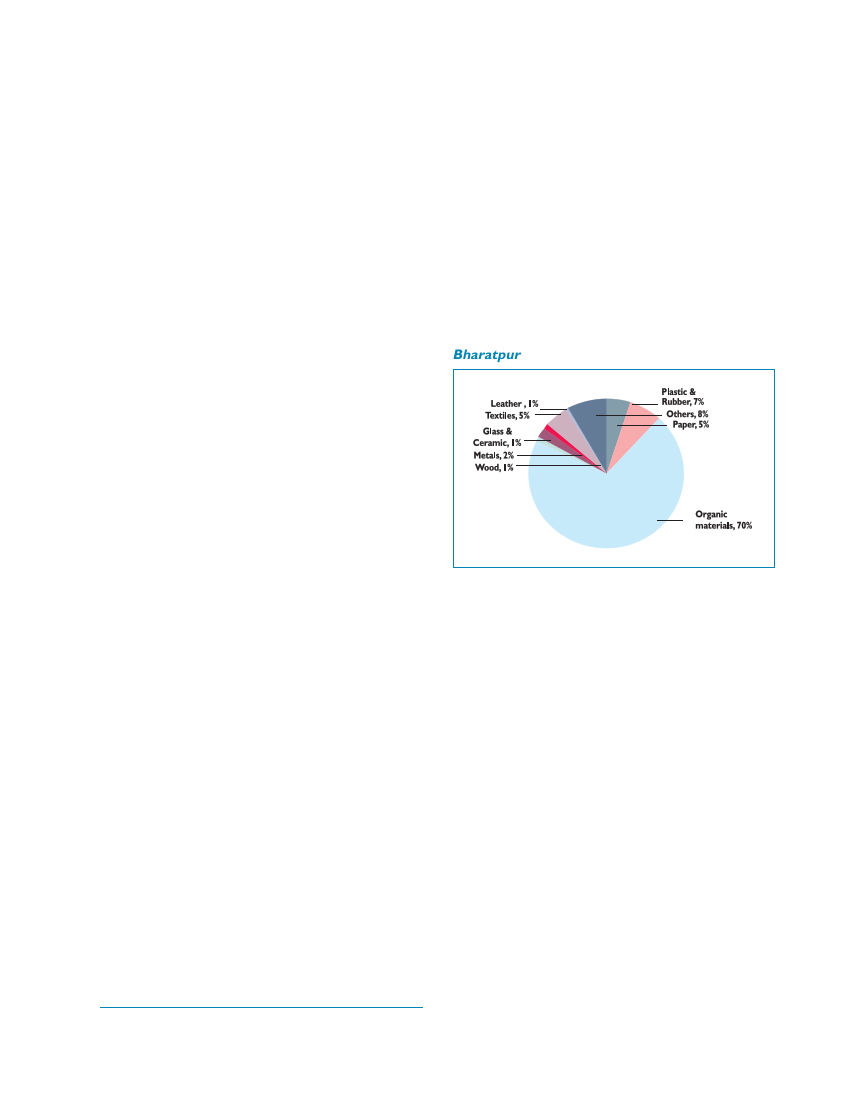
BEST PRACTICES ON SOLID WASTE MANAGEMENT OF NEPALESE CITIES
Waste from unofficial collection points is brought to official
transfer stations which are located in two areas of the
municipality. After receiving complaints of bad odours from
people in the main market area, the contractor is using the
transfer stations alternately, for 15 days at a time.
The main objective of the proposed waste management
system in this municipality is to maintain a clean and
healthy environment by involving the private sector.
Waste generation and composition
According to the data provided by the municipality and
the field survey conducted in May 2008, the average HH
waste generation rate is 0.276 kg/capita/day, which is
slightly higher than the national average of 0.25 kg/capita/
day and lower than the rate for the Kathmandu valley,
which is 0.39kg/capita/day (SWMRMC, 2008 data). Using
this generation rate it is estimated that the total generation
of waste in Bharatpur municipality is 37 tons. The
municipality estimates that only 20 tons are being
collected by the municipality each day, 6 tons/day being
of commercial origin and the remaining 14 tons/day being
HH waste (Bharatpur municipality, 2008 data). Therefore,
only around 54 per cent of the generated waste was being
collected and dumped by the municipality. The waste
generation may be slightly lower than the estimate
because most of the Bharatpur's population lives in
relatively rural and semi-urban areas.
Healthcare waste is supposed to be managed by the
hospitals and nursing homes themselves by incineration
and dumping in trenches within the compound, but during
the field visit it was observed that private nursing homes
were not serious about the management of infectious
healthcare waste. There are altogether three government
hospitals and ten private nursing homes, providing a
total bed capacity of 1975 (Bharatpur municipality, 2008
data). According to UN-HABITAT Nepal, the waste
generation rate for hospital waste in Nepal is 1.7 kg/
day/bed (UN-HABITAT, KMC data, 2007); on this basis it
is estimated that about 3.3 tons of healthcare wastes are
generated in this municipality each day.
The composition of municipal solid waste at source is found
to be paper 5 per cent, plastic & rubber 7 per cent, organic
materials 70 per cent, glass and ceramic 1 per cent, metal
2 per cent, wood 1 per cent, textiles 5 per cent, leather 1 per
cent and other miscellaneous materials 8 per cent (Bharatpur
municipality, 2008 data), as shown in Chart 3 below.
Waste collection and recycling
Waste is collected from unofficial collecting points in
almost 70 per cent of the areas in the urban wards. The
contractor is responsible for collecting waste from
various stations to dispose in the disposal site.
Previously, metal containers were used for waste
Chart 3: Composition of solid waste at source ,
Bharatpur municipality
storage, but the residents objected to them because of
the bad odours it produced. Every day at 7.00 a.m.,
the contractor starts the collection of waste from wards
1, 2, 3, 4 & 5 (Bharatpur municipality, 2008 data).
In order to encourage waste reduction at source, HH
composts and the segregation of plastic waste using
suiro hooks for storage have been promoted in some of
the wards. In Shaulibazar-10 area the local community
has initiated segregation of waste at source for
composting and vermicomposting (which uses
worms?and the recovery of plastics. Similarly, in order
to collect waste from surroundings, residents of
Shantinagar-7 area have installed small waste bins;
especially for inorganic waste, in peripheral areas.
With the partial support from Lumanti18 , Practical
Action Nepal and local NGOs, a 40 m3 biogas plant is
under construction in ward no.5 of Bharatpur. There
are 180 low-income residents in this area. The input
for the plant will include wastewater from 18 low-
income HHs (Bharatpur municipality, 2008 data).
18 An NGO especially working for the welfare of slums and squatter communities.
15